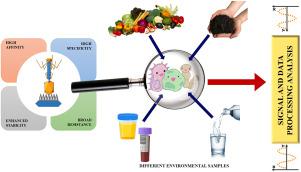Environmental Technology & Innovation ( IF 6.7 ) Pub Date : 2020-08-05 , DOI: 10.1016/j.eti.2020.101081 Simranjeet Singh , Daljeet Singh Dhanjal , Sonali , Siddharth Thotapalli , Vijay Kumar , Shivika Datta , Vineet Kumar , Manoj Kumar , Joginder Singh

|
Pathogenic bacteria have become a global issue and has affected various sectors like food, health and environmental monitoring, which has made the detection and identification of these pathogenic bacteria of utmost importance. Bacterial infections are the leading cause of most fatalities, often due to delay in diagnosis or misdiagnosis. Therefore, pathogenicity assessment of these bacteria has become crucial in understanding the disease dynamics. Although, conventional bacterial identification and characterization techniques like microscopic and molecular methods are available, being cost-intensive, time-consuming and tedious, makes it unsuitable for rapid analysis. There are raising concern about bacterial detection and pathogenicity assessment, which has prompted the researchers to exploit and develop biosensors derived from diverse bio-probes like enzymes, RNA, DNA, antibodies etc. However, bacteriophage-based biosensor system offers numerous advantages like cost-effectiveness, high affinity, high specificity, more stability and resistance towards various environmental factors like ion concentrations, pH and temperature. Therefore, the current review intends to highlight different bacterial detection techniques and facilitate with the basics of the biosensor. Additionally, it also discusses the different bio-probes used for biosensor development. Furthermore, it will also discuss the different types of phage-based biosensors and their importance.
中文翻译:

基于噬菌体的生物传感器的见解,重点在于其检测方法和最新进展
病原菌已成为全球性问题,并已影响到食品,健康和环境监测等各个领域,这使得对这些病原菌的检测和鉴定极为重要。细菌感染是大多数死亡的主要原因,通常是由于诊断或误诊延迟所致。因此,这些细菌的致病性评估已成为了解疾病动态的关键。尽管可以使用常规的细菌鉴定和表征技术,例如显微镜和分子方法,但它们成本高,耗时且繁琐,因此不适合进行快速分析。人们越来越关注细菌的检测和致病性评估,这促使研究人员开发和开发源自多种生物探针(例如酶,RNA,DNA,抗体等)的生物传感器。然而,基于噬菌体的生物传感器系统具有许多优势,例如成本效益,高亲和力,高特异性,更高的稳定性和稳定性。对各种环境因素(如离子浓度,pH和温度)的抵抗力。因此,当前的综述旨在强调不同的细菌检测技术,并促进生物传感器的基础知识。此外,它还讨论了用于生物传感器开发的不同生物探针。此外,还将讨论基于噬菌体的生物传感器的不同类型及其重要性。高亲和力,高特异性,更高的稳定性以及对各种环境因素(如离子浓度,pH和温度)的抵抗力。因此,当前的综述旨在强调不同的细菌检测技术,并促进生物传感器的基础知识。此外,它还讨论了用于生物传感器开发的不同生物探针。此外,还将讨论基于噬菌体的生物传感器的不同类型及其重要性。高亲和力,高特异性,更高的稳定性以及对各种环境因素(如离子浓度,pH和温度)的抵抗力。因此,当前的综述旨在强调不同的细菌检测技术,并促进生物传感器的基础知识。此外,它还讨论了用于生物传感器开发的不同生物探针。此外,还将讨论基于噬菌体的生物传感器的不同类型及其重要性。











































 京公网安备 11010802027423号
京公网安备 11010802027423号